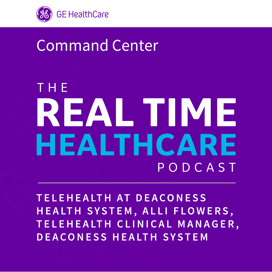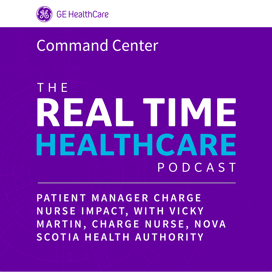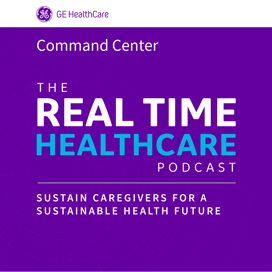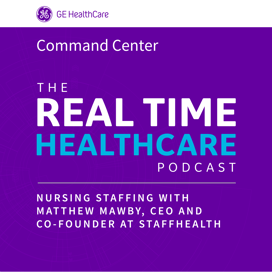#35 - Dr. Peter Chang, VP of Care Transitions at Tampa General Hospital
May 10 · 15:30 min
In this Episode:
In this podcast episode, Jeff Terry is joined by Dr. Pete Chang of Tampa General Hospital. They discuss regional Covid collaboration, the importance of real-time optimization, Capacity Snapshot, and much more.
Jeff Terry:
Hello and welcome. I'm Jeff Terry, delighted to be joined by Dr. Pete Chang of Tampa General Hospital. Hi Pete.
Dr. Peter Chang:
Hey Jeff. How's it going?
Jeff Terry:
Wonderful. Great to be with you. First thing I wanted to ask about is during COVID, Tampa General, and you personally, were leaders in organizing COVID care in the west Florida region, if you will. Could you talk about that regional COVID collaboration?
Dr. Peter Chang:
Sure, Jeff. So, one thing here in Florida, in regards to COVID that we had, that was sort of a luxury was time. We saw what was happening in New York and how overwhelming COVID was to their healthcare system. And we, we looked within our regional healthcare collaborative and thought, "What's a good way we could prepare?" And one of the primary ways we decided to do that was with data. So, knowing how many admissions our neighboring hospitals were receiving, even though they were not part of our hospital system. Our CEOs got together and decided to exchange their data in regards to overall census, ventilator utilization, hospital occupancy in regards to COVID patients. And what it allowed us to do was create an exchange where we had over 50 hospitals up and down the Western coast of Florida, that were submitting their data to TGH. And we created a click dashboard that would have a real-time information on what was going on in the other hospitals.
And I'll tell you locally, it was a huge help, because when we had skilled nursing facilities that may have had outbreaks, or worried about patients that were developing, COVID, when they would offload 10 patients at a time, we were able to work with our county using the information from that dashboard to make sure those 10 patients didn't appear at one emergency department. We were able to distribute it equally and proportionately, as to how the overall hospital was in regards to their COVID census. And in fact, their non-COVID census, because that's what we saw. As COVID hit us, and we came out of the safe at home, our regular patient census really rose at the same time, too. So, it was balancing all these different factors at the same time, which that dashboard allowed us to do. And it really evolved into with your help, the Florida capacity system.
Jeff Terry:
Absolutely. And what's remarkable about that are probably a lot of things, but one piece of it is, I think, the courage of the leaders to break through the political, or whatever you want to call that, but natural hesitancy about sharing data with other health systems, which I think Tampa was one of the first examples of that nationally. We Ended up doing that in Oregon and other places, but can you talk about, how did that happen?
Dr. Peter Chang:
Yeah, it's basically "coopatition," as our CEO calls it. It's our competitors in the market, but also our neighbors that we partner with to take care of the health and wellness for our entire community. And so, I think it's through the foresight of our leaders, our CEO is John Couris. And working with the other CEOs from the big systems in our area, really allowed us to open up the gates to exchange the information on the first level. And then as I was speaking of earlier, then collaborate and really use that information.
Jeff Terry:
To actually allocate capacity, which is a pretty remarkable achievement. HCA, AdventHealth, BayCare, you guys came together to make that happen. So, you mentioned that work eventually moved into some of our software, which is all about real-time optimization. Behind you is a beautiful view of CareComm, which is the center of gravity for that at Tampa General. But the idea of that of course, is all about real-time optimization. So, can you talk about for the audience, why is real-time optimization so difficult and important in a big, busy place like Tampa General?
Dr. Peter Chang:
Great, Jeff. As a physician at heart, I take it down to the level of a patient. Knowing exactly what's going on with a patient as it's happening is extremely important in an acute care setting. And that's on the micro scale. You bubble that up to running an entire thousand bed hospital in a single facility. And that real time information is pivotal to make decisions that would impact the future of care at our hospital. As in the future, in the next couple hours. It allows us to be a little bit perspective, instead of being reactive to these things that were already happening, but we couldn't see.
And because we couldn't see them, we couldn't appropriately plan for the future, whether it was what beds we were going to use. I would say COVID, again, was a premium example of this. Capacity snapshot, for example became so important, because we would be able to balance our capacities on the non COVID side and for our COVID patients that were sick coming in through our ED. It really allowed us to air traffic control appropriately. And it's the perfect analogy. How can you tell which planes you have to land if you don't know where they are? here in the Command Center, we're able to get that real-time information and use it and apply it.
Jeff Terry:
And can you answer a common question, because you have a great EMR, from a great EMR company, and yet there's something different going on here with real- which I know that people will sometimes ask you, "How is this different? How does this compliment your great EMR?"
Dr. Peter Chang:
Yeah. And it's a great question and something we frequently get asked. And I really think it's a couple of things. The first is the amalgamation of data from multiple different pieces of an EMR, that you can't get in one view. EMR's are very role specific. So, if you're a physician, you have a certain view. If you're a nurse, you have a different view. Being able to have one unified view in which everyone is reading the information from the same interface is very important. And that's really what it allows it to do. You don't have to worry about who's got what template, how they're viewing the data. It standardizes, "Listen, this is our capacity. These are the other Tiles that we're working on, where everyone is going to see the same information." And then you can start to build roles off of, "Okay, now that this information is displayed, who's doing what with it?" And the expectations around who's doing what become much clearer.
Jeff Terry:
Because now you have real time visibility to who's were, waiting for what, et cetera.
Dr. Peter Chang:
And everyone's seeing the same thing. That's the most important.
Jeff Terry:
So, let's go a bit further. I thought we talk about two of the Tiles, maybe, which of course is our word for app. But first is the Imaging Expediter app, and then second is patient Manager. So starting with Imaging Expediter, how is that used? How does it help?
Dr. Peter Chang:
Sure. So, I would say the first use we have it for it here at TGH, is to make sure that the next patient that's inline from a prioritization standpoint gets that study done. So, at any given time, let's look at MRIs, for example, we're going to have the patients with stroke alerts and patients that maybe have a rule out bone infection in their foot. So, how does the radiology technician know how to prioritize things, especially when you have five stroke alerts, all at the same time and only three MRIs. Who's getting that next study. So, it really helps us allow to look at what we call patient attributes. So, is this patient in an ICU? Do they have a high deterioration score? Are they more sick than the other person? So we can really prioritize who gets the next study.
Dr. Peter Chang:
Another use that we have forward is looking at what we call multi-modality patients. Frequently in the hospital, you'll have patients with an MRI and an ultrasound all at the same time. And so instead of going from the room to one modality and back, and then repeating that all over again with the other modality, like an ultrasound, we'll try to coordinate and plan between modalities, so that the patient goes from the room to, let's say, an ultrasound machine, then an MRI machine, and then back to their room. So, it decreases duplication in regards to transport.
The last thing we use the Tile for is really to look at our volumes. We can track our volumes by what's on the elective schedule, days ahead of time. And we can learn to figure out how we would shift volume, potentially, if we know that historically Tuesdays and Wednesdays, it's the middle of the week where volumes are really high. If we see a very high volume over the weekend, or the Friday before that week, we could potentially reschedule patients that were coming into the hospital for an elective MRI to an outpatient facility of one of ours, or one of our partners, so we can open up in patient capacity before we actually need it.
Jeff Terry:
Preserve the capacity. That's brilliant. And then the other Tile I wanted to hear your take on was Patient Manager, which for the audience, of course you have Patient Manager. And you have a bunch of automation around discharge planning. You have automation around discharge barriers and you have automation around ICU downgrades, and that Tile is used behind you to some degree in CareComm, but it's also used out on the nursing units and in the ICU. So, can you talk about Patient Manager?
Dr. Peter Chang:
Sure. It's interesting, Jeff, when you look at all the Tiles, they were always geared towards a specific purpose. Like you mentioned, Imaging Expediter, or Care Progression. But when we start looking at Patient Manager, I love the Tile, because it really centers and focuses around each individual patient on a unit. And I think that's really the future of developing a structure to appropriately organize all the stuff that's coming in from our Command Center.
When we look at downgrades, the units are using those to start the conversation with physicians on if a patient is appropriate for downgrade to a lower level of care. We have right around 150 adult ICU beds in our hospital, and that's quite a bit, but we always need more. And so easily identifying patients from the standpoint of, "Hey, this patient doesn't meet the ICU criteria out of close to 50 different elements," and being pulled out of the EMR and putting some logic to it. To at least start the conversation with the physicians, when we do our multidisciplinary rounds to say, "Hey we're not really seeing that this patient is ICU level. What do you think?" And it's really up to the physician to make that determination, but it's really a great conversation starter.
I'll tell you how it used to work before this Tile, Jeff. On a Saturday morning, if we were strapped for ICU beds, I would jump into the EMR and start to sort almost exactly off the same criteria we're using for downgrades, which patients are on ventilators? Well, they're automatically not eligible for downgrade. And then what level of oxygenation were the next set of patients on. And then I'd have to go through chart by chart and look at the elements that the Tile's actually pulling out and presenting. So, I know in an instant right now that these are the ones that are eligible, that have orders, so nothing to do there. These are the ones that are eligible that don't have orders, and that's really where the conversation starts. And then of course you have the patients that don't meet criteria that hopefully will, as they heal in the next couple of days.
Jeff Terry:
Absolutely. And that's a brilliant example, by the way, of how it compliments it. Saving all that time from having to dig through the chart, because it's just not built that way. The other thing to clarify for our audience, a common question I get, the algorithm of when a patient is ICU ready, GE didn't give that to Tampa General. Your team told us, "These are the criteria we're using," and we've just organized the information so that instead of you clicking around, it's just, boom, there it is. This patient meets the criteria that you gave us.
Dr. Peter Chang:
Yeah, Jeff, I couldn't agree more. It's really the partnership of bringing the technology and the availability to sort the data in a meaningful way. And then the clinical input from our nursing teams, our physicians, our case managers, our respiratory therapist, our physical therapist and occupational and speech therapist. It's so many people coming together to create the criteria to say, "Yeah, but when we talk about a neuro ICU, it's going to be completely different than a cardiothoracic ICU." And so there's probably, I don't know, maybe around 60, 70% of criteria that go across all the ICU's. And then there's an additional level of work that goes to specify, let's say a lumbar drain, or an EBD, something that measures your intracranial pressures, those are ICU specific from a neuro perspective. And so we built that specific logic in for the neuro side. And then we're embarking on moving on to our heart and vascular side in the next couple of weeks.
Jeff Terry:
Brilliant. Last question. Another important piece of this puzzle is the Clinical Expediter, which I like to think of as the eye in the sky that's using all these smarts, to be proactive and call a unit and say, :Hey, I noticed something. Can I help you?" And that's my interpretation. How would you describe the Clinical Expediter?
Dr. Peter Chang:
I'm a big car guy, Jeff, so I would probably say they're the engine oil of the Command Center. They're the thing that keeps things cool. That's one job of an engine oil. And the other part is to, of course, lubricate. So, what I mean by that is any of those barriers that the team on the unit is having trouble working, we want the autonomy of those units to be able to address those. But if it hits a certain point where they're spending more time on it than they should and taking away from potentially working on other patients' care, they could pass that to our Clinical Expediter or through the escalation function in the Tiles. So, no phones need to be picked up. You just need to identify the barrier escalate, and then our Clinical Expediter will grab that, take a hold of it, and work it, and then close the loop with the person who put in the escalation.
So, that's what I mean. They're really lubricating all the squeaky wheels inside the organization to make sure everything is running smoothly, and really providing that extra set of eyes. That's for the barriers. We really hope to move beyond those daily management of barriers, really, to looking at how are we progressing on clinical pathways? To me, that's the true value of a clinical, ours is a registered nurse, here in CareComm, that's looking to see which patients are on pathway. And then if a patient does fall off the pathway, we just need to know why, and be able to track that and measure it, so we could potentially fine-tune the pathway in the future. So to me, that's really where the proof in the pudding is, in regards to what the Clinical Expediter does, is actually pushing stuff way beyond the discharge barrier side of things, and more to diagnosis earlier, treatment earlier. And then of course getting them to their next level of care earlier.
Jeff Terry:
Well, we can't wait to keep working on those topics with you. Pete, I think it's amazing. Thank you again. Great to see you, always.
Dr. Peter Chang:
Thanks so much, Jeff. Thanks for having me.
Jeff Terry:
And with that, I will close the podcast.







